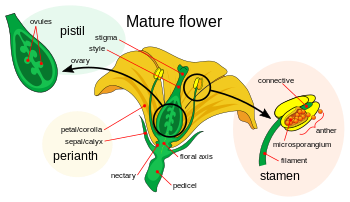Plant sexuality

Diagram showing the sexual parts of a mature flower
It was
Rudolf Camerarius
(1665–1721) who was the first to establish plant sexuality conclusively
by experiment. He declared in a letter to a colleague dated 1694 and
titled
De Sexu Plantarum Epistola
that “no ovules of plants could ever develop into seeds from the female
style and ovary without first being prepared by the pollen from the
stamens, the male sexual organs of the plant".
Much was learned about plant sexuality by unravelling the reproductive mechanisms of mosses, liverworts and algae. In his
Vergleichende Untersuchungen of 1851
Wilhelm Hofmeister
(1824–1877) starting with the ferns and bryophytes demonstrated that
the process of sexual reproduction in plants entails an “alternation of
generations” between
sporophytes and
gametophytes.
This initiated the new field of
comparative morphology which, largely through the combined work of
William Farlow (1844–1919),
Nathanael Pringsheim (1823–1894),
Frederick Bower,
Eduard Strasburger and others, established that an "alternation of generations" occurs throughout the plant kingdom.
Some time later the German academic and natural historian
Joseph Kölreuter
(1733–1806) extended this work by noting the function of nectar in
attracting pollinators and the role of wind and insects in pollination.
He also produced deliberate hybrids, observed the microscopic structure
of pollen grains and how the transfer of matter from the pollen to the
ovary inducing the formation of the embryo.

Angiosperm (flowering plant) life cycle showing alternation of generations
One hundred years after Camerarius, in 1793,
Christian Sprengel
(1750–1816) broadened the understanding of flowers by describing the
role of nectar guides in pollination, the adaptive floral mechanisms
used for pollination, and the prevalence of cross-pollination, even
though male and female parts are usually together on the same flower.
Nineteenth century foundations of modern botany
In about the mid-19th century scientific communication changed. Until
this time ideas were largely exchanged by reading the works of
authoritative individuals who dominated in their field: these were often
wealthy and influential "gentlemen scientists". Now research was
reported by the publication of “papers” that emanated from research
“schools” that promoted the questioning of conventional wisdom. This
process had started in the late 18th century when specialist journals
began to appear.
Even so, botany was greatly stimulated by the appearance of the first “modern” text book,
Matthias Schleiden's (1804–1881)
Grundzüge der Wissenschaftlichen Botanik, published in English in 1849 as
Principles of Scientific Botany.
By 1850 an invigorated organic chemistry had revealed the structure of many plant constituents.
Although the great era of plant classification had now passed the work of description continued.
Augustin de Candolle (1778–1841) succeeded
Antoine-Laurent de Jussieu in managing the botanical project
Prodromus Systematis Naturalis Regni Vegetabilis
(1824–1841) which involved 35 authors: it contained all the
dicotyledons known in his day, some 58000 species in 161 families, and
he doubled the number of recognized plant families, the work being
completed by his son
Alphonse (1806–1893) in the years from 1841 to 1873.


No comments:
Post a Comment